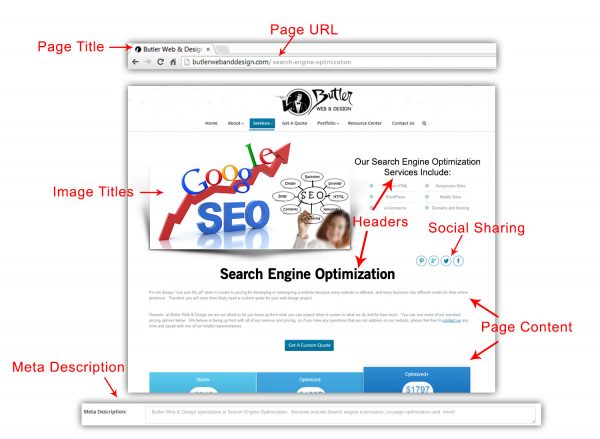What is on page SEO?
On Page SEO can be simply defined as the steps taken to optimize your web pages to be easily found by search engines whenever someone does a search for whatever it is that your page is about. On page optimization doesn’t negate the fact that good content is the key to good rankings. Rather, on page optimization ensures that your good content is formatted correctly so that search engines can easily identify and rank it. Below is a graphic showing some of the typical types of content on any given webpage that needs to be search engine optimized.
What page elements need to be optimized?
For this particular page, there are 7 things I need to consider for on page SEO:
- Page Title (title tag)
- URL
- Headers (H-tags)
- Page content
- Image Titles
- Meta Description
- Social Sharing (building your page with the expectation that it will be shared)
Step 1: Produce good content
The first step is to produce really good content. You don’t want to create a page just so you can get better search engine rankings. It won’t work. You want to create a page with good, unique, relevant content that people who read it would want to share. Remember this simple rule: create content first for visitors, and second for search engines. Search engines are only designed to replicate human processes, so if a human wouldn’t want Google pulling up that content, then Google more than likely won’t pull up that content.
Step 2: Determine your focus keyword
Your focus keyword is a single keyword or short phrase that sums up what the content is about. Try to narrow it down to the most specific topic your content is about, because you only get one. For the example in the above image, the focus keyword I chose was “search engine optimization”.
Step 3: Optimize your page elements
After you have produced your awesome, informative, fun to read, shareable content, and you have selected the focus keyword you want to rank for, then it’s time to make sure you look at the seven elements I listed above to make sure that focus keyword is in each one.
Note: if you are building a website using WordPress, the SEO Plugin by Yoast is a great tool for on page optimization in selecting your focus keyword, meta description, and SEO Title.
FOR EXAMPLE:
The example in the image above is a fictitious page about Search Engine Optimization (it doesn’t really exist – yet). It’s designed for anyone looking for information about Search Engine Optimization services. It shows pictures relating to SEO, different levels of SEO services, prices for SEO, etc. Naturally, if the content was written well, it should have enough uses of the keyword “search engine optimization”. Therefore, that is the focus keyword selected for this page, and the keyword I will embed into the seven elements listed above.
- The picture is titled “search-engine-optimization-butler.jpg”
- The Title Tag is “Butler Web & Design-Search Engine Optimization”
- The headers contain the keyword “Search Engine Optimization”
- The URL reads: “http://www.butlerwebanddesign.com/search-engine-optimization”
- Etc…
Taking the time to add your focus keyword to these elements assists Search Engines in ranking your page for that particular keyword.
CAUTION:
What you don’t want to do is try to manipulate your entire website by inundating every element of every page with a particular keyword. Keep in mind that if your focus keyword is not relevant to the content you are creating, it will end up hurting you in the long-run.
Does Butler offer these services?
I’m glad you asked! Butler offers on page optimization services as either a standalone service, or bundled together with our website design services. So whether you have an already existing website that you want on-page optimization services for, or you want to create a brand new website that’s optimized from the start, we can help you.
Call (559) 797-3414 today to speak with an Account Manager, and we would be glad to help.





